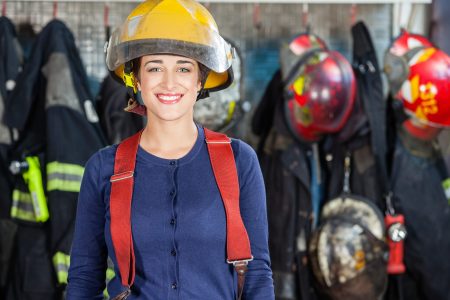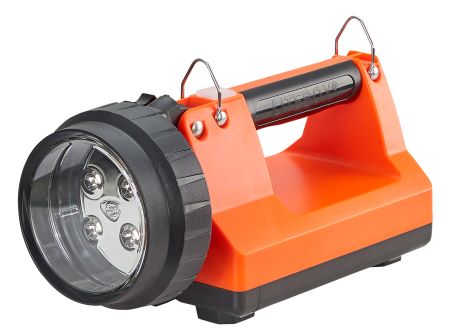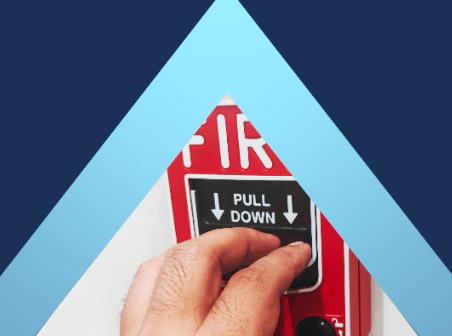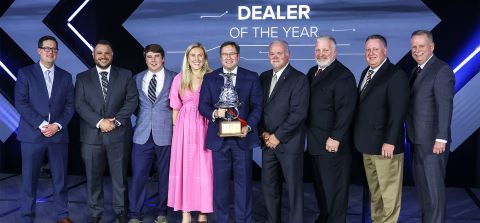Chuck Stravin, Vice President, Business Development & Operations, NFPA discusses the intricacies of training during Covid-19 exclusively for Fire Buyer magazine
The author of, “Necessity is the mother of invention” is unknown, but the meaning sure is not. “New ways to do things are found or created when there is a strong and special need for them,” is how Merriam-Webster’s explains it. To fully appreciate the saying, though, we need only look back to last year when COVID-19 challenged us all to look at what we normally did with fresh eyes.
As the head of business operations for the National Fire Protection Association (NFPA), I can assure you that NFPA has looked at everything the past year with fresh eyes.
During an unprecedented time in history, our association stepped up and generated needed resources – showing exactly why NFPA is widely regarded as a global life safety authority. We released guidance on code requirements, emergency response, ITM, mobilising healthcare, policymaking, tents, remote inspections, hand sanitisers, and more. We shared information and knowledge via fact sheets, breaking news coverage, NFPA Journal stories, translated content, blogs, infographics, videos, webinars, white papers, and podcasts to ensure that safety was kept at the forefront during a tumultuous period. Our response was, and remains, a prime example of NFPA’s more nimble approach to business.
We also launched new training and certification solutions. These offerings were in the pipeline before COVID, but we fast-tracked releases to help bridge the knowledge gap during a time when safety was called into question.
We debuted two online courses (OLL) – Life Safety and Fire Protection Systems Fundamentals and NFPA 25 ITM of Water-Based Fire Protection Systems. The Life Safety course, unlike most NFPA training, does not deeply discuss codes, but rather explains how various codes (NFPA and others) impact these systems. The self-paced fundamentals course touches on key concepts and terminology; and provide a broad understanding of egress, building systems, occupancy, and use, building rehabilitation, emergency planning, detection and alarms, and sprinkler systems via expert-developed content, videos, and interactive exercises that follow a worker who is reviewing various facility systems. The NFPA 25 OLL looks at the latest revisions to the code and covers everything needed for maintaining water-based fire protection systems including sprinklers, fire pumps, water tanks and more via videos, custom animation components, and interactive activities where the stakeholder can navigate through different ITM scenarios.
Three Live Virtual Training (LVT) courses which incorporate dynamic interactive online components with real-world scenarios came next. The training trio helps practitioners stay up to speed on electrical and life safety requirements per the most recent editions of NFPA 70, National Electrical Code (NEC), NFPA 70E, Standard for Electrical Safety in the Workplace and NFPA 101, Life Safety Code. Live expert-led courses feature polling, chat, activities, exercises, videos, downloadable summaries, and job aids to help various stakeholders locate, interpret, and apply code requirements. The NEC course addresses safe and compliant electrical installation and design, and helps participants locate, interpret, and apply requirements and recognise potential problems, while the NFPA 70E training was developed to help reduce electrical dangers in the workplace that cause hundreds of deaths and thousands of injuries each year. The Life Safety Code (2018) Essentials Live Virtual Training helps facility managers, inspectors, safety directors, engineers, architects, designers, risk managers, facility consultants, and project managers apply requirements from NFPA 101 to better protect building occupants. The course addresses the latest technologies, design approaches, and challenges and provides the tools to apply or enforce requirements related to means of egress, occupancy load, vertical openings, hazardous areas, and high-rise buildings. It also looks at building services, operating features, and building rehabilitation.
Not to be outdone, our certification team released new Learning Path programs to help professionals prepare for certification credentials. Stakeholders looking to prepare for Certified Fire Protection Specialist (CFPS), Certified Fire Inspector (CFI-I), and Certified Fire Plan Examiner (CFPE) exams can customise their studying approach to include individual online training modules or a full program with more comprehensive educational content. One of the many unique NFPA Learning Path features is a navigation tool that helps stakeholders plot out their long-range learning approach in advance of the certification exam date. Learning Paths include a practice exam component, as well as a final Capstone activity to test knowledge and core responsibilities.
The Certified Fire Protection Specialist (CFPS) Learning Path documents competency and offers professional recognition for fire protection professionals, risk managers, loss control specialists, fire officers, fire marshals, fire inspectors, safety managers, fire protection consultants, designers, engineers, code enforcers, facility managers, building owners, and others responsible for the application of fire safety, protection, prevention, and suppression technologies. Modules have been created with material from the NFPA Fire Protection Handbook (FPH) and feature expert videos, interactive 3D fire scene investigation tools, official research reports and news reports of fire incidents, knowledge checks, and quizzes at the end of every module. The interactive, online course is based on the new 2020 CFPS examination content outline. The Certified Fire Inspector I (CFI-I) Learning Path is great for those planning to take the Certified Fire Inspector I examination. Participants learn about the job performance requirements for the Fire Inspector I level as defined in the 2014 edition of NFPA 1031, Standard for Professional Qualification for Fire Inspector and Plan Examiner and benefit from a full online CFI-I learning program. The track includes 10 modules specifically designed to prepare the CFI-I candidate for the exam and an additional 21 modules that provide in-depth training on codes and standards.
Like the CFI-I program, the Certified Fire Plan Examiner certification exam is based on NFPA 1031 and also includes NFPA 1 Fire Code, NFPA 13 Standard for the Installation of Sprinkler Systems, NFPA 72 National Fire Alarm and Signaling Code and NFPA 101. The course mirrors the certification exam blueprint and includes expert video commentary, interactive 3D tools, case studies, and regulation-changing fire-incident videos.
If you put time into learning, on some level, you want people to know, right? That is why we introduced digital badges which allow stakeholders to promote their professional achievements on LinkedIn, Twitter, Facebook, Pinterest and via email signatures, resumes or HTML cards. In short, badging shows that a person has successfully developed a certain skill or met an educational requirement in a visual, shareable way.
NFPA offers three badge levels:
- A Bronze Badge (Awareness) that demonstrates successful completion of a learning program and fundamental knowledge of facts and ideas
- A Silver Badge (Knowledge) that shows successful completion of a learning program and application of acquired knowledge, facts, techniques and rules
- A Gold Badge (Analysis) that emphasises successful completion of a learning program and the ability to analyse content, present opinions or make judgements about the information based on a set of criteria
NFPA online training courses currently offer badging:
- Swinging Fire Door Inspection
- 2021 NFPA 3000: Active Shooter / Hostile Event Response
- 2019 NFPA 241: Safeguarding Construction, Alteration, and Demolition Operations
- Construction Site Fire Safety Fundamentals
- Fire and Life Safety Operator
- Fire Prevention Program Manager (coming April 2021)
These new NFPA training solutions may have been expedited to help with professional development during a pandemic, but as the NFPA Fire & Life Safety Ecosystem suggests, an investment in education always pays dividends. The Ecosystem calls for a skilled workforce that helps reduce the risk of injuries, loss, and death for workers and the public. We all play a role in safety. If you are looking to skill up to better protect people and property, NFPA is here to help.
Commentary: David Bouwkamp, Executive Director Business Development at FAAC
Last year FAAC Incorporated teamed up with XVR Simulation. Together, we introduce the most immersive and realistic incident management simulation training platform available to US Fire Departments to date, called inCommand. With the Coronavirus pandemic virtual and e-learning training solutions are being widely used to maintain safety against the virus.
Real-life training is an excellent way to develop competencies but is often time-consuming and expensive. Virtual simulation using fully immersive 3D worlds enables FAAC to train safety and security professionals realistically for events and incidents, without the dangers, costs and time associated with traditional training.
inCommand uses the XVR Simulation Platform to create realistic, fully immersive 3D training environments for all hazards training. The inCommand simulation allows emergency crews to experience the incident as they would in real life. They assess the situation and determine the best response strategy, implement it and then observe the consequences of their decisions.
XVR gives us the realism and the flexibility required by our end users. We can create incident management scenarios at FAAC and our users can also create their own scenarios using XVR’s user-friendly interface. Together we will help prepare safety and security professionals for all types of incidents.
Commentary: Cosumnes Fire Chief Mike McLaughlin
Over the past five or six years we’ve been developing relationships and partnerships with a number of different companies really to find ways to leverage technology. At the end of the day, nothing compares to live fire training. The goal (of virtual reality training) is to get as close to that as we can.
Our department has used the technology in a classroom setting to train recruits on how to battle wildland and structural fires. In these exercises, the focus has been on teaching fire behavior and the progression of fire development and footage was collected of actual blazes in order to create the video simulation.
Each of the students that goes through the virtual reality side is given the heads-up display that not only has the virtual reality goggles, but it also has earpieces for the audio side of being involved with it. And then the instructor is able to work off of an iPad to control where things are, able to pause it, tell everybody to look up to their left, look up to their right. Having a heads-up display in, having the virtual reality experience with the goggles on, you are there, you’re in the moment.—obviously you don’t have the heat or the other limitations—and the instructor is able to walk you through.
To stay up to date on the latest, trends, innovations, people news and company updates within the global fire market please register to receive our newsletter here.
Media contact
Rebecca Morpeth Spayne,
Editor, International Fire Buyer
Tel: +44 (0) 1622 823 922
Email: editor@firebuyer.com









